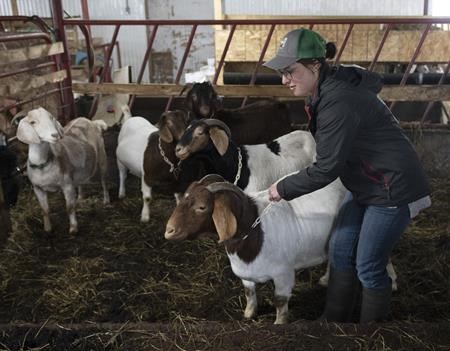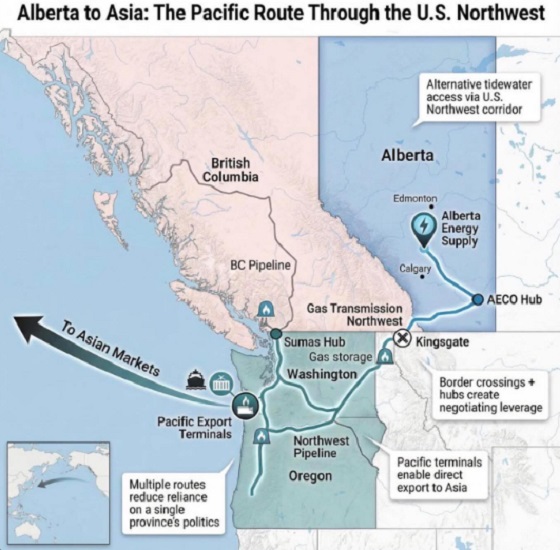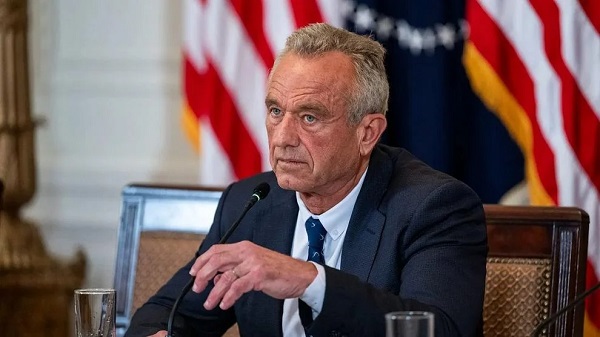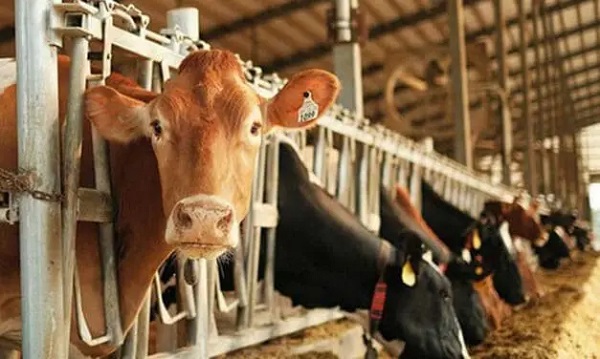Alberta
High costs putting farming out of reach for young people, affecting all Canadians

MONTREAL — When Myriam Landry started raising goats for their meat in 2018, she started small — because she had to.
She opened Chèvrerie aux Volets Verts, in St-Esprit, Que., with two goats; she couldn’t afford a large herd and chose animals small enough that she could handle on her own while pregnant with her third child.
“I should have started bigger … but then I would have needed more money, which I didn’t have,” Landry, 33, said in a recent interview from her farm 50 kilometres north of Montreal.
“It’s really hard for young people to start … I don’t even have land, I don’t have tractors, even my goats (I paid for) on loans.”
The rising cost of land is making it harder than ever for young farmers to enter the business. And those barriers come at a time when a growing number of older farmers are planning to leave the industry. Organizations promoting farm succession worry that if young people are unable to enter the industry, only the largest companies will endure, reducing the diversity of crops and livestock and widening the gap between Canadians and their sources of food.
“The main challenge right now is really the cost of agricultural land,” said Benoît Curé, co-ordinator of ARTERRE, a program that pairs aspiring farmers with landowners and farmers planning to retire.
Curé said multiple factors are contributing to rising prices, including real estate speculation — especially near Montreal suburbs — and strong competition for the best soil in a province where only around two per cent of the land is suitable for farming.
Last year, the price of agricultural land rose by 10 per cent, which isn’t unusual, he said in a recent interview. “Over the last 10 years, we’ve had annual increases of about six to 10 per cent.” The average dairy farm in Quebec is now valued at almost $5 million, he said, almost double what it was in 2011.
With 20 per cent down payments usually expected for farm purchases, “you have to almost be a millionaire before starting your agricultural business,” Curé said. If young people can’t afford to get into farming, then most rural communities risk being left with two or three large farms, he lamented.
Landry, like more than half of the aspiring farmers who have worked with ARTERRE, is renting her space. Her small operation is located on a former dairy farm that’s now used for hay and cereal crops. Her farm has now grown to 40 female goats and a handful of males for breeding. There’s enough space in her barn for 60 females, she said, but she has enough demand to support 100.
And while starting small has allowed her to open a farm, it has also come with its own challenges. Goat meat, she said, is uncommon in Quebec, and financial institutions are hesitant to lend to money for an operation they aren’t familiar with.
Lenders, she said, “don’t want to finance it, because they don’t know it, and that makes it really hard.”
Farming has always been a capital-intensive industry — with high costs for land, equipment and inputs — but prices across Canada have risen above the revenue that can be generated from that land, said Jean-Philippe Gervais, the chief economist of Farm Credit Canada, a Crown corporation that lends to farmers.
“The relationship between the price of the land and the revenue that can be expected from the land — that ratio is the highest we’ve ever seen,” Gervais said in a recent interview. “So we’re really at prices that are the highest we’ve ever seen, not just in absolute value in dollars per hectare, but also relative to what can be generated in income.”
It’s now rare for farmers to turn a profit from land they buy just by farming it, he said, adding that most farmers only make their money back when they sell. Large, established farms can fund the purchase of more land from the revenue generated on land that’s already been paid for, he added.
But even large farms are challenged by high costs. A survey of more than 3,600 farmers released last month by Quebec’s farmers association found that 11 per cent are thinking about closing over the coming year. The Union des producteurs agricoles found that costs on Quebec farms rose by an average of 17.3 per cent in 2022 while revenues rose by an average of 14.7 per cent.
A report released in early April by RBC found that 40 per cent of Canadian farm operators planned to retire over the next decade and that 66 per cent didn’t have a succession plan.
Julie Bissonnette, the president of an organization that represents young Quebec farmers and promotes farm succession, says there are many young people interested in agriculture.
“Sometimes you hear there’s no one to take over, but it’s not true, there are a lot, but we need to make sure they’re able to set up,” Bissonnette, with the Fédération de la relève agricole du Québec, said in a recent interview. “It’s so much money.”
Urban sprawl and the influx of people moving to rural areas to work remotely is putting increased pressure on Quebec’s arable land, Bissonnette said.
Landry, meanwhile, said she’d like to see more small-time farmers because they tend to build close relationships with local residents.
“We need to reconnect the public to what they do three times a day, which is eat,” she said. “Know where your food is coming from. If you can’t grow it yourself, find someone who does it the way you would do it.”
This report by The Canadian Press was first published May 7, 2023.
Jacob Serebrin, The Canadian Press
Alberta
Ottawa-Alberta agreement may produce oligopoly in the oilsands

From the Fraser Institute
By Jason Clemens and Elmira Aliakbari
The federal and Alberta governments recently jointly released the details of a memorandum of understanding (MOU), which lays the groundwork for potentially significant energy infrastructure including an oil pipeline from Alberta to the west coast that would provide access to Asia and other international markets. While an improvement on the status quo, the MOU’s ambiguity risks creating an oligopoly.
An oligopoly is basically a monopoly but with multiple firms instead of a single firm. It’s a market with limited competition where a few firms dominate the entire market, and it’s something economists and policymakers worry about because it results in higher prices, less innovation, lower investment and/or less quality. Indeed, the federal government has an entire agency charged with worrying about limits to competition.
There are a number of aspects of the MOU where it’s not sufficiently clear what Ottawa and Alberta are agreeing to, so it’s easy to envision a situation where a few large firms come to dominate the oilsands.
Consider the clear connection in the MOU between the development and progress of Pathways, which is a large-scale carbon capture project, and the development of a bitumen pipeline to the west coast. The MOU explicitly links increased production of both oil and gas (“while simultaneously reaching carbon neutrality”) with projects such as Pathways. Currently, Pathways involves five of Canada’s largest oilsands producers: Canadian Natural, Cenovus, ConocoPhillips Canada, Imperial and Suncor.
What’s not clear is whether only these firms, or perhaps companies linked with Pathways in the future, will have access to the new pipeline. Similarly, only the firms with access to the new west coast pipeline would have access to the new proposed deep-water port, allowing access to Asian markets and likely higher prices for exports. Ottawa went so far as to open the door to “appropriate adjustment(s)” to the oil tanker ban (C-48), which prevents oil tankers from docking at Canadian ports on the west coast.
One of the many challenges with an oligopoly is that it prevents new entrants and entrepreneurs from challenging the existing firms with new technologies, new approaches and new techniques. This entrepreneurial process, rooted in innovation, is at the core of our economic growth and progress over time. The MOU, though not designed to do this, could prevent such startups from challenging the existing big players because they could face a litany of restrictive anti-development regulations introduced during the Trudeau era that have not been reformed or changed since the new Carney government took office.
And this is not to criticize or blame the companies involved in Pathways. They’re acting in the interests of their customers, staff, investors and local communities by finding a way to expand their production and sales. The fault lies with governments that were not sufficiently clear in the MOU on issues such as access to the new pipeline.
And it’s also worth noting that all of this is predicated on an assumption that Alberta can achieve the many conditions included in the MOU, some of which are fairly difficult. Indeed, the nature of the MOU’s conditions has already led some to suggest that it’s window dressing for the federal government to avoid outright denying a west coast pipeline and instead shift the blame for failure to the Smith government.
Assuming Alberta can clear the MOU’s various hurdles and achieve the development of a west coast pipeline, it will certainly benefit the province and the country more broadly to diversify the export markets for one of our most important export products. However, the agreement is far from ideal and could impose much larger-than-needed costs on the economy if it leads to an oligopoly. At the very least we should be aware of these risks as we progress.

Elmira Aliakbari
Alberta
A Christmas wish list for health-care reform

From the Fraser Institute
By Nadeem Esmail and Mackenzie Moir
It’s an exciting time in Canadian health-care policy. But even the slew of new reforms in Alberta only go part of the way to using all the policy tools employed by high performing universal health-care systems.
For 2026, for the sake of Canadian patients, let’s hope Alberta stays the path on changes to how hospitals are paid and allowing some private purchases of health care, and that other provinces start to catch up.
While Alberta’s new reforms were welcome news this year, it’s clear Canada’s health-care system continued to struggle. Canadians were reminded by our annual comparison of health care systems that they pay for one of the developed world’s most expensive universal health-care systems, yet have some of the fewest physicians and hospital beds, while waiting in some of the longest queues.
And speaking of queues, wait times across Canada for non-emergency care reached the second-highest level ever measured at 28.6 weeks from general practitioner referral to actual treatment. That’s more than triple the wait of the early 1990s despite decades of government promises and spending commitments. Other work found that at least 23,746 patients died while waiting for care, and nearly 1.3 million Canadians left our overcrowded emergency rooms without being treated.
At least one province has shown a genuine willingness to do something about these problems.
The Smith government in Alberta announced early in the year that it would move towards paying hospitals per-patient treated as opposed to a fixed annual budget, a policy approach that Quebec has been working on for years. Albertans will also soon be able purchase, at least in a limited way, some diagnostic and surgical services for themselves, which is again already possible in Quebec. Alberta has also gone a step further by allowing physicians to work in both public and private settings.
While controversial in Canada, these approaches simply mirror what is being done in all of the developed world’s top-performing universal health-care systems. Australia, the Netherlands, Germany and Switzerland all pay their hospitals per patient treated, and allow patients the opportunity to purchase care privately if they wish. They all also have better and faster universally accessible health care than Canada’s provinces provide, while spending a little more (Switzerland) or less (Australia, Germany, the Netherlands) than we do.
While these reforms are clearly a step in the right direction, there’s more to be done.
Even if we include Alberta’s reforms, these countries still do some very important things differently.
Critically, all of these countries expect patients to pay a small amount for their universally accessible services. The reasoning is straightforward: we all spend our own money more carefully than we spend someone else’s, and patients will make more informed decisions about when and where it’s best to access the health-care system when they have to pay a little out of pocket.
The evidence around this policy is clear—with appropriate safeguards to protect the very ill and exemptions for lower-income and other vulnerable populations, the demand for outpatient healthcare services falls, reducing delays and freeing up resources for others.
Charging patients even small amounts for care would of course violate the Canada Health Act, but it would also emulate the approach of 100 per cent of the developed world’s top-performing health-care systems. In this case, violating outdated federal policy means better universal health care for Canadians.
These top-performing countries also see the private sector and innovative entrepreneurs as partners in delivering universal health care. A relationship that is far different from the limited individual contracts some provinces have with private clinics and surgical centres to provide care in Canada. In these other countries, even full-service hospitals are operated by private providers. Importantly, partnering with innovative private providers, even hospitals, to deliver universal health care does not violate the Canada Health Act.
So, while Alberta has made strides this past year moving towards the well-established higher performance policy approach followed elsewhere, the Smith government remains at least a couple steps short of truly adopting a more Australian or European approach for health care. And other provinces have yet to even get to where Alberta will soon be.
Let’s hope in 2026 that Alberta keeps moving towards a truly world class universal health-care experience for patients, and that the other provinces catch up.
-

 International2 days ago
International2 days agoGeorgia county admits illegally certifying 315k ballots in 2020 presidential election
-

 Business1 day ago
Business1 day agoSome Of The Wackiest Things Featured In Rand Paul’s New Report Alleging $1,639,135,969,608 In Gov’t Waste
-

 Business2 days ago
Business2 days agoWarning Canada: China’s Economic Miracle Was Built on Mass Displacement
-

 Alberta2 days ago
Alberta2 days agoWhat are the odds of a pipeline through the American Pacific Northwest
-

 International2 days ago
International2 days agoCommunist China arrests hundreds of Christians just days before Christmas
-

 Alberta2 days ago
Alberta2 days agoA Christmas wish list for health-care reform
-

 Energy1 day ago
Energy1 day ago‘The electric story is over’
-

 Alberta1 day ago
Alberta1 day agoOttawa-Alberta agreement may produce oligopoly in the oilsands










